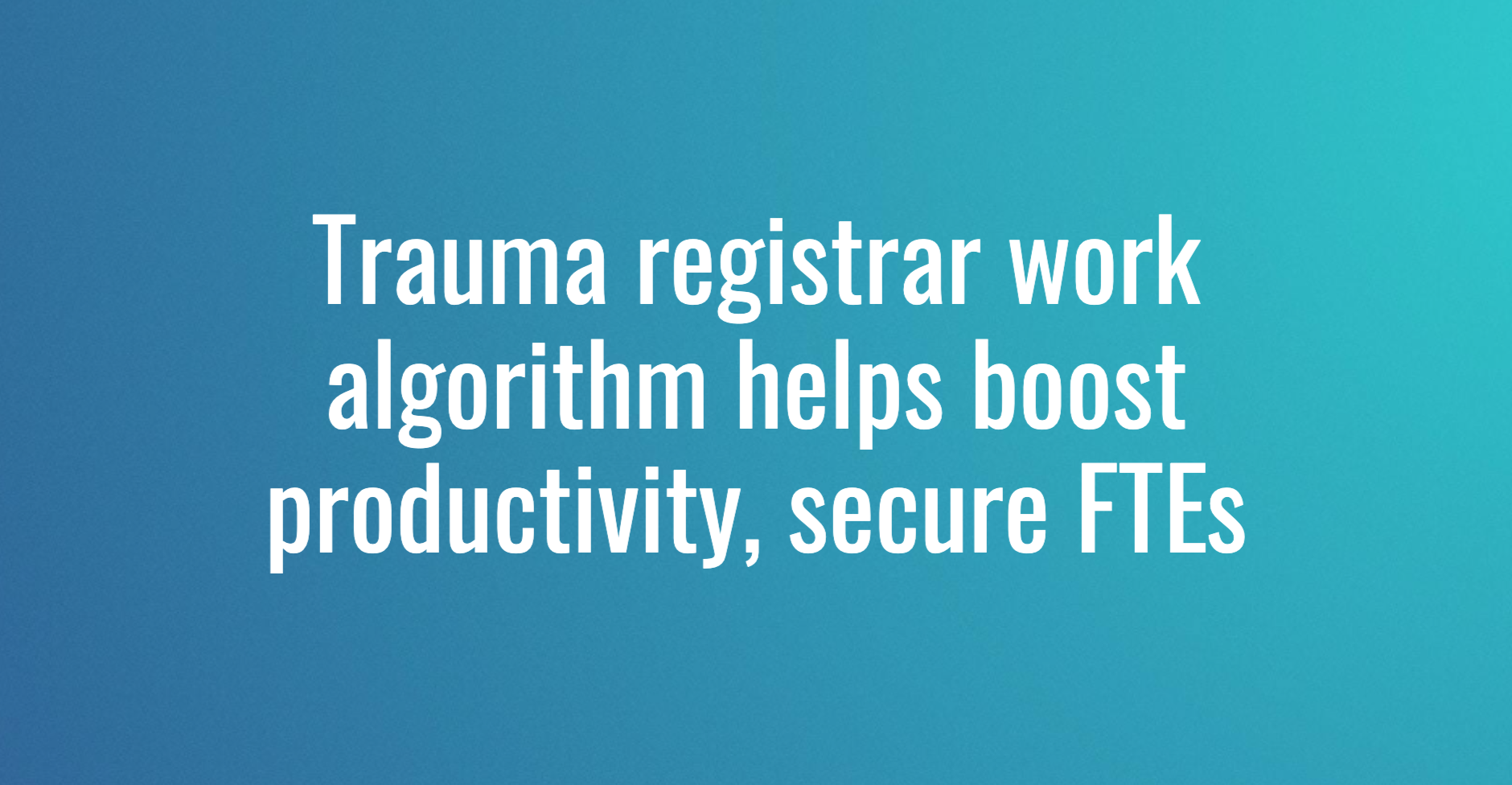Many trauma program managers have a hard time evaluating the productivity of individual trauma registrars. A registrar who abstracts eight complex charts in a week might be just as productive as one who works through 15 uncomplicated cases during the same period.
How can you tell which registrars are working efficiently and which are falling behind? According to Kelly Jo Evans, BSN, RN, TCRN, the solution is to create an analytic model that uses patient variables to predict chart abstraction time.
Evans is the trauma program manager at Charleston Area Medical Center (CAMC), a Level I trauma center in Charleston, West Virginia. She recently collaborated with Damayanti Samanta, MS, lead trauma research associate, to develop an algorithm that predicts the time required to abstract a trauma patient chart. The duo described their work in a paper published in the November-December 2020 issue of the Journal of Trauma Nursing.
How to develop a registrar work algorithm
Trauma program leaders who want to develop a registrar productivity model need to work collaboratively with the registry team. The CAMC project involved a three-step process:
Identify suspected factors. Evans began by asking the trauma registrars at her center to identify the patient factors they thought increased chart abstraction time. The team flagged issues like inter-facility transfer, involvement of multiple EMS agencies, higher number of blood products, higher number of procedures and longer inpatient stay. These and other factors were the focus of the analysis.
Run a time study. Registrars were then asked to track the time they spent on each chart using a stopwatch. The time study involved all four registrars, and it was run for 8 months.
Perform data analysis. A total of 600 charts were randomly selected (150 for each registrar) for analysis. Samanta used various analytic techniques to identify the patient factors that drive chart abstraction time. She also produced an algorithm that uses patient-level variables to predict chart abstraction time. The patient variables in the algorithm are:
- In-hospital mortality
- Transfer from a referring facility (yes/no)
- Hospital stay (days)
- Ventilator days
- Number of complications
- Number of specialty consults
- Diagnosis of TBI (per TQIP criteria)
- Blood product count
- Procedure count
Because the algorithm accounts for chart complexity, it provides TPMs with a standard measure for evaluating and comparing registrar productivity. According to Evans, this can help TPMs do three things:
1. Increase the productivity of individual trauma registrars
Every month, the lead registrar at CAMC runs a spreadsheet report to capture key productivity data. The query captures:
- Every chart abstracted during the month
- The registrar who abstracted the chart and the time required to perform the abstraction
- All the patient variables included in the productivity algorithm
Evans then sends the report to Samanta, who feeds all the chart information and patient parameters into the algorithm. The result is a report that details each registrar’s predicted abstraction time (for all the charts they worked on) and their actual variation from predicted time, either positive or negative.
“For example, a monthly report might show that a registrar had a variation of 59% for the period, meaning the registrar took longer than the predicted time for 59% of the charts he or she worked on,” Evans said.
Evans maintains a separate report that trends this productivity data month to month. She also shares it with registry staff during team meetings.
“I assign each registrar a number so the results are anonymous but everyone knows who they are,” she said. “That way, everyone knows where they sit within the department.”
According to Evans, the ability to compare performance has led to better overall productivity. “We have been doing this for more than two years, and the gap between individual registrars has really narrowed,” she said. “In terms of variation, they are all very close to each other now.”
2. Build metrics into trauma registrar performance plans
Evans now includes productivity metrics in each registrar’s annual performance plan. For example, a performance plan goal might be to meet the predicted abstraction time for 90% of charts.
“It was not my intent when we started this project to use the model in the planner, but as a trauma program manager I need some way to assess performance,” Evans said. “If Registrar 1 is hitting the goal 90% of the time and Registrar 2 is never hitting it, I can’t give them the same evaluation.”
3. Demonstrate additional registry FTE needs to hospital administration
It can be hard to convince hospital administrators that trauma registry backlogs are caused by insufficient staffing. The chart abstraction time model helped Evans make a strong case for hiring additional registrars.
“There was always the suggestion that the registrars just needed to work faster,” Evans said. “After we created the model and closed our productivity gap, I was able to demonstrate that they were working as fast as they can.”
Using the chart abstraction time algorithm and CAMC’s trauma patient data, Evans was able to pinpoint the number of FTEs needed to maintain a concurrent registry. Administration approved an additional full-time employee for the trauma registry.
“The model helped us demonstrate that this was a manpower issue for us,” Evans said. “Unless all of the sudden our patients are 50% less injured than when we modeled this, our workforce need is not going to change.”
The model can also be used to predict total abstraction time requirements during the high-volume summer months. This helps Evan plan vacation time for trauma registrars.
Must be custom built
Evans noted that a work algorithm is predictive for only a specific group of trauma registrars. An algorithm developed for one registry team will not be accurate for a different team.
“You can’t just take our numbers and use them for your registrars,” Evans said. “You would have to do a time study within your own department and then use that data to build your own algorithm.”

